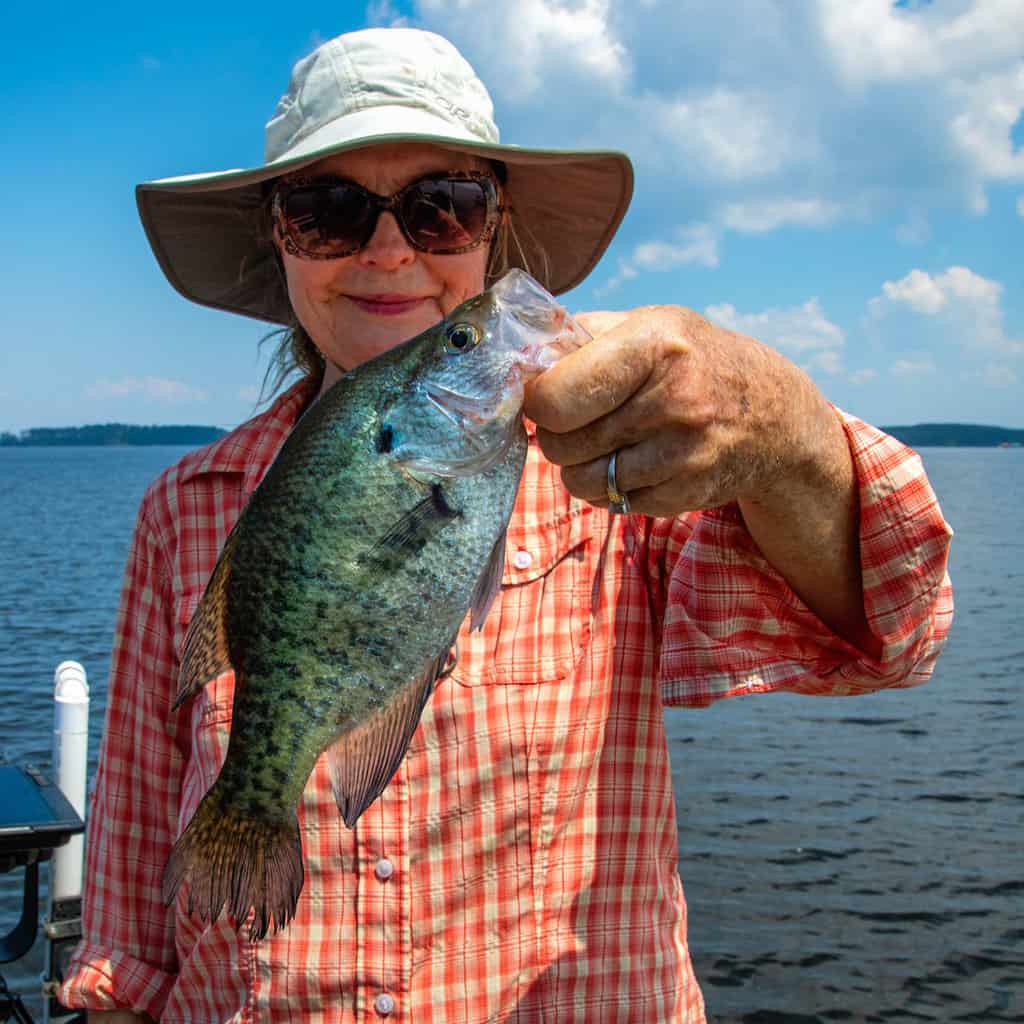Rambling along the state line between Texas and Louisiana, Toledo Bend Reservoir is frequently counted among America’s best fishing lakes. It was created in 1969 for water storage and hydroelectric power, but also provides some incredible fishing opportunities.
At 185,000 acres, Toledo Bend is a beast. It’s the largest reservoir in either of the states that it touches, with 1,200 miles of shoreline and stretching 65 miles from north to south along the Sabine River.
All that water can be intimidating. T-Bend offers an abundance of fish, but picking a spot to wet a line on such a vast lake can leave anglers struggling with where to begin.
Luckily, largemouth bass, catfish, crappie and other game fish are so abundant that you can hardly go wrong.
But you can always do better. So, we’re here to show you when, where and how to catch the top sport fish in Toledo Bend Reservoir, starting with some of the most prized species in America.
Largemouth Bass Fishing
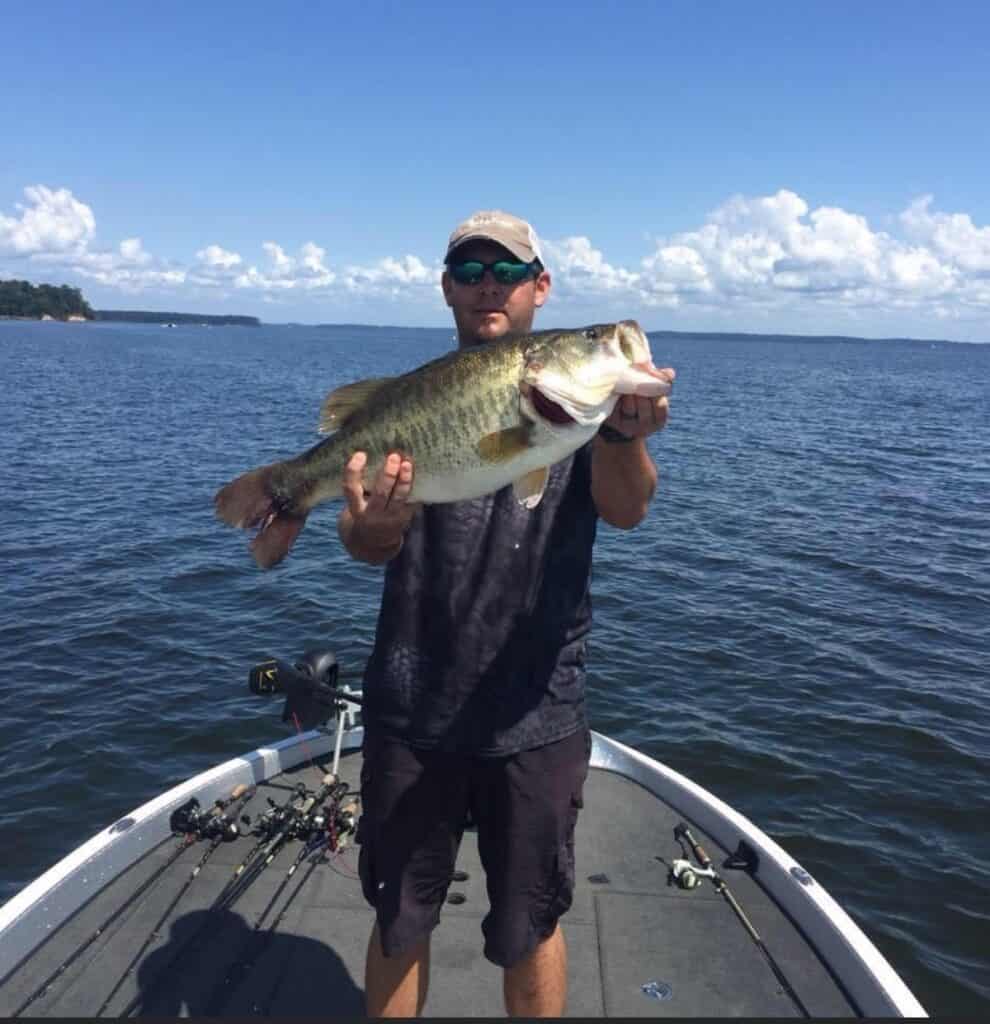
Easily one of the best trophy bass lakes in Texas and Louisiana, Toledo Bend Reservoir is a legendary largemouth lake that has landed the top spot on Bassmaster Magazine’s annual ranking of the best bass lakes in America on multiple occasions.
Toledo Bend produces dozens of 10-pound bass every year and also continues to maintain a healthy largemouth population in every size class. With such a wealth of habitat and forage, suffice it to say, bass do very well here.
Anglers tend to have the most success in spring and fall, with midsummer being the most challenging time for bass fishing on Toledo Bend. Most years, largemouths are in pre-spawn mode throughout February and bed down from March into April.
The magic number for spawning bass is 68 to 72 degrees. Male bass move into the shallows first, followed by big females. Therefore, fishing shoreline areas and backs of creek channels is crucial this season.
For anglers looking to take advantage of the spawn, it’s important to remember that not all bass spawn at the same time. Due to the sun’s direction in early spring, northeastern shores warm up first, and bass will spawn there sooner.
Look for flooded shoreline vegetation like buckbrush and water willow, which provide key spawning habitat in Toledo Bend Reservoir.
The maze of channels and brushy islands at the upper end of the lake offers a lot of this type of habitat and can be excellent during the spawn.
Another great area is north of Pendleton Bridge on the Louisiana side. Generally referred to as the 1215 area (named for the submerged road that lies under the lake), this stretch is loaded with picture-perfect spawning habitat.
Spinnerbaits and lipless crankbaits can be excellent when bass are staging before the spawn, while Texas- and Carolina-rigged soft plastics are among the best baits for bedding bass.
Black/blue, watermelon, junebug and green pumpkin are some of the top colors.
From April into June, bass transition into post-spawn patterns, heading toward main lake structure like points and channel edges. Housen Bay, on the Texas side, is a great area with a range of depths that continues to be productive as bass finish spawning and head deeper.
Bass mostly stick to deep haunts in summer, but you’ll find them chasing schools of shad on the main lake.
As Toledo Bend cools in the fall, bass follow creek channels back into shallower coves. Try topwaters, shallow crankbaits and soft plastics along the edges of grass beds.
Many of the best fall bass spots are also good in the spring. Best bets include Pirate’s Cove, Indian Creek, Mill Creek, Bayou San Miguel, Indian Mounds, Six Mile Bay and Tennessee Bay.
Catch More Largemouth Bass
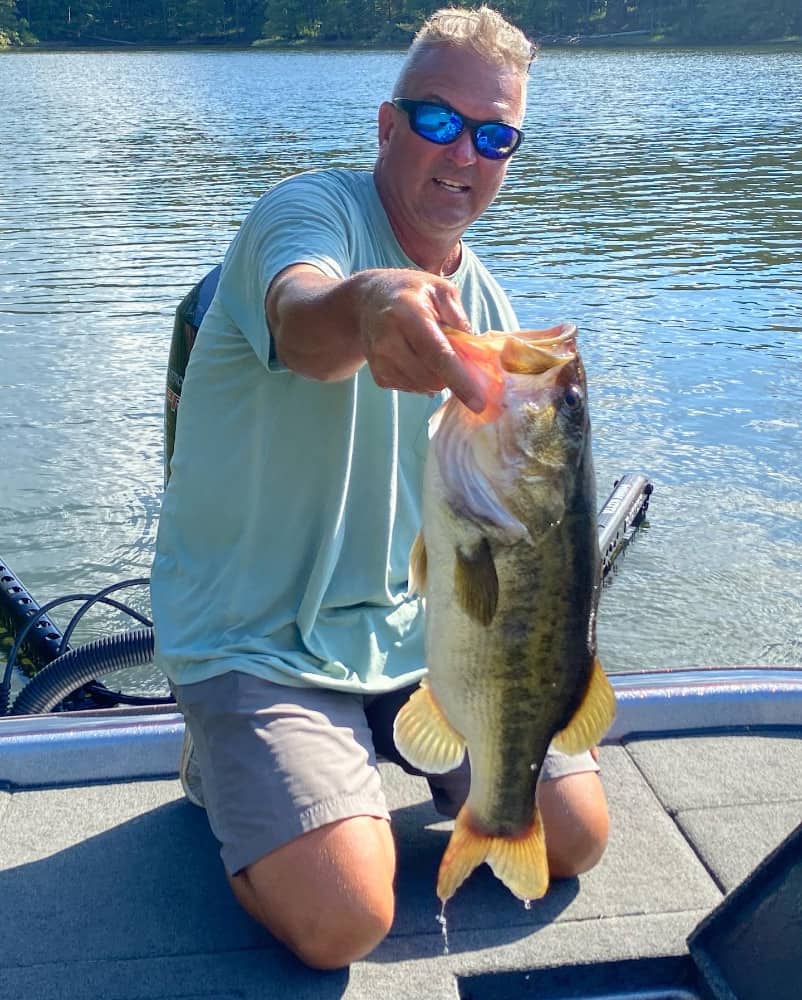
Toledo Bend was an easy choice for our articles on the best bass fishing lakes and rivers in Louisiana and the best bass fishing lakes in Texas. It’s also in our narrower article about the best bass fishing lakes near Houston (it’s a good drive, but worth it).
Any of those articles will point you to even more trophy bass fishing spots where you want to fish.
If you’re just getting into this sport, check out our simple introduction to some of the best bass fishing techniques, lures, gear and other tips.
Crappie Fishing
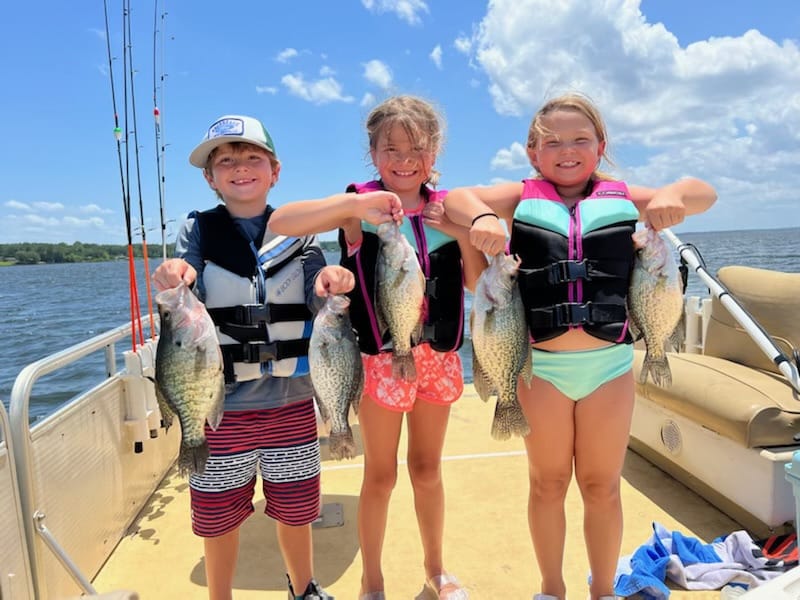
Toledo Bend Reservoir is a truly outstanding crappie lake, and one which continues, year after year, to produce remarkable numbers of crappie, including plenty of slabs upwards of 2 pounds.
The spring spawn is the period many crappie anglers are programmed to look forward to, but Toledo Bend’s crappie fishing actually hits its stride much earlier.
Some of the very best crappie fishing is in winter when crappies follow schools of shad down the main river channel.
There are a lot of places to catch crappies during January and February, but the number one spot is known as the Chicken Coop.
Named for the long-gone commercial chicken houses that once overlooked the shore, this area is located on a deep bend in the Sabine River channel, about 4 miles north of Pendleton Bridge on the Texas side.
When the crappies show up, you’ll know it by the fleet of anglers that follow almost immediately.
Crappie usually congregate right at the edge of the channel about 30 feet down. It’s almost impossible not to catch them here on a lively minnow.
Once March rolls around, Toledo Bend typically starts to see warming spells that drive crappie into shallow waters.
Crappies seek the warmest waters they can find in late winter and early spring, and a difference of just a degree or two can draw crappies to dark-bottomed shallows.
Crappies follow grass lines and creek channels toward the backs of creeks and coves, often using brush as cover along the way. Toledo Bend has a ton of brush, some naturally occurring and some put there by anglers, at a wide range of depths.
Spider rigging is a productive way to track down crappies on the brush as they transition from the river channel toward nearshore areas in March, eventually reaching spawning sites amid shallow stumps, standing timber and brush.
Great spring crappie spots in Toledo Bend are too numerous to list, but try around San Miguel and Bayou Siepe in the upper part of the lake or in Housen Bay and Mill Creek.
Toledo Bend has ample populations of both black and white crappies. Black crappies are most abundant in the deeper, clearer lower end of the reservoir, while white crappies thrive in the more turbid waters farther north.
Catch More Crappie
Toledo Bend also made our spotlights for having some of the best crappie fishing in Texas and also some of the best crappie fishing in Louisiana. In fact, it wasn’t a close call. Check those articles for more great crappie fishing in your state.
We also have a simple but complete guide to crappie fishing techniques and tips, including the best lures and live bait choices.
Catfish Fishing
Toledo Bend Reservoir offers a spectacular catfish fishery, and one that is considerably underutilized compared to more popular species like bass and crappie.
But anglers in the know will tell you it’s one of the best cat lakes in either Texas or Louisiana.
All three major catfish species—channel catfish, blue catfish and flathead catfish—are present in healthy numbers. Channel catfish are the most abundant, occasionally topping 20 pounds but more commonly tipping the scales between 2 and 4 pounds.
Blue catfish are less common but reach gargantuan proportions. Anglers have landed blues over 60 pounds in Toledo Bend.
That said, the biggest catfish caught in the reservoir are usually flatheads, which can top 70 pounds and are considered by many to be the best catfish for the table.
Local anglers bait brush piles and other catfish holes with soured grain or commercial cattle feed, a tactic that is best for channel catfish and can attract a mess of them in as little as 10 minutes.
The idea is to use enough chum to attract catfish but not so much that they eat their fill.
After baiting your spot, wait a few minutes and then drop your hook and line nearby. Good baits include chicken livers, nightcrawlers, stink baits and dough baits.
Trotlines and juglines are more commonly employed to catch blue cats and flatheads, but rod and reel anglers also have plenty of success. Use cut bait for blues and live shad or sunfish for flatheads.
Summer is a favorite time to fish blue catfish. When Toledo Bend stratifies, blues reliably suspend above mid-lake humps, usually right around the thermocline, which is typically about 15 feet below the surface.
If flathead catfish are your quarry, the best time to fish is after dark or right around first light in the summer. That’s when flatheads leave deep holes to prowl shallow flats.
Fish live bait just off the bottom on flats with lots of timber near the creek channel to improve your odds.
Every part of Toledo Bend Reservoir has the potential to produce big catfish and lots of them. However, the upper end of the lake, with its grassy islands and braided channels and sloughs, is a perfect place to start.
Bayou San Miguel, a large arm on the Louisiana side of the lake, is also a tremendous catfish area. It has all the habitat catfish love: flooded timber, creek channels and shallow flats, with several creeks continuously feeding fresh water and nutrients.
There is also excellent fishing in the Sabine River below Toledo Bend Reservoir. This stretch is magnificent when more water is released from the dam, increasing the river’s flow and triggering catfish to feed.
Catch More Catfish
Apologies for sounding like a broken record, but Toledo Bend also made it into our run-downs of the best catfish fishing spots in Louisiana and the best catfish fishing lakes in Texas.
Find more details on the top catfishing tackle, bait and tactics in our complete catfish fishing how-to guide.
Other Toledo Bend Fish Species
Bluegill & Sunfish
There’s a case to be made that Toledo Bend is one of the best panfish lakes in America. Hand-sized bluegill and sunfish are incredibly abundant, and some individuals measure 10 inches and weigh nearly a pound.
Bluegill are the most frequently caught species, but redear sunfish (also known as shellcrackers) are nearly as common and grow just as big. Warmouth, redbreast and longear sunfish are also present. Many anglers in these parts use the term “bream” (pronounced like “brim”) to refer to bluegill or more broadly all sunfish.
Bream are some of the easiest fish to catch, readily falling for a live red worm or cricket beneath a float.
A variety of small jigs are also effective on ultralight tackle, and some fly anglers catch bluegill and sunfish using small poppers and terrestrials.
The prime season for bluegill and sunfish is April into May, when they congregate on shallow flats, humps and ridges to spawn. They dig circular nests in large colonies, and you may see the bottom honeycombed with hundreds of nests.
The ideal depth range this time of year is 3 to 8 feet of water.
You will likely find picture-perfect spawning flats south of the Pendleton Bridge on the Texas side of the river channel. Areas with a bit of grass, reeds or lily pads are ideal.
Other good areas include Patroon Bayou, north Housen Bay, Six Mile Bay, the flats in Pirates Cove, and around the islands at the upper end of the reservoir.
After the spawn in summer, focus on spots where grass beds drop off to river and creek channels around 6 to 10 feet.
Catch More Bluegill and Sunfish
Ready to bust some bream? We have a simple guide to bluegill and sunfish fishing, including favorite baits, lures and flies.
We’ve also assembled a modest but top-notch collection of the best bluegill and sunfish fishing lakes in Texas.
White Bass
White bass may not be first on most anglers’ lists of the fish they’re out to catch in Toledo Bend Reservoir. But every winter and spring, white bass have their moment in the spotlight when they go on an epic spawning run up the Sabine River.
Commonly weighing about a pound but capable of topping 4 pounds, white bass are incredibly abundant in Toledo Bend, though they go unseen by most anglers throughout most of the year.
In January, they head up the lake to stage en masse near the mouth of the Sabine River. Some white bass also gather around other tributaries, but the bulk of the run takes place on the Sabine.
While they gather at the uppermost end of the lake, anglers can catch their limit tossing Roadrunner jigs, curlytail grubs, Zoom Flukes and all manner of spinners and spoons.
Schools of white bass may be in just a few feet of water, and kayak anglers do very well this time of year.
White bass head up the river when water temperatures approach 55 degrees. Local wisdom holds that when redbud trees are in bloom, the white bass are on the move.
There are great opportunities for bank anglers on the Sabine River around the Logansport, Louisiana area.
Once the fish return to the lake in March and April, focus on points, sand bars and bends in the river channel at the upper end of the reservoir. White bass will continue to migrate south farther into the lake in spring and summer, following the river channel.
Catch More White Bass
One of our writers learned to catch white bass almost before he could walk. Check out his simple guide to white bass fishing tactics and tips, including his favorite lures.
Also, we have a comprehensive guide to the very best white bass fishing spots in Texas, paired up as rivers and lakes that produce the most eye-popping runs.
Striped Bass
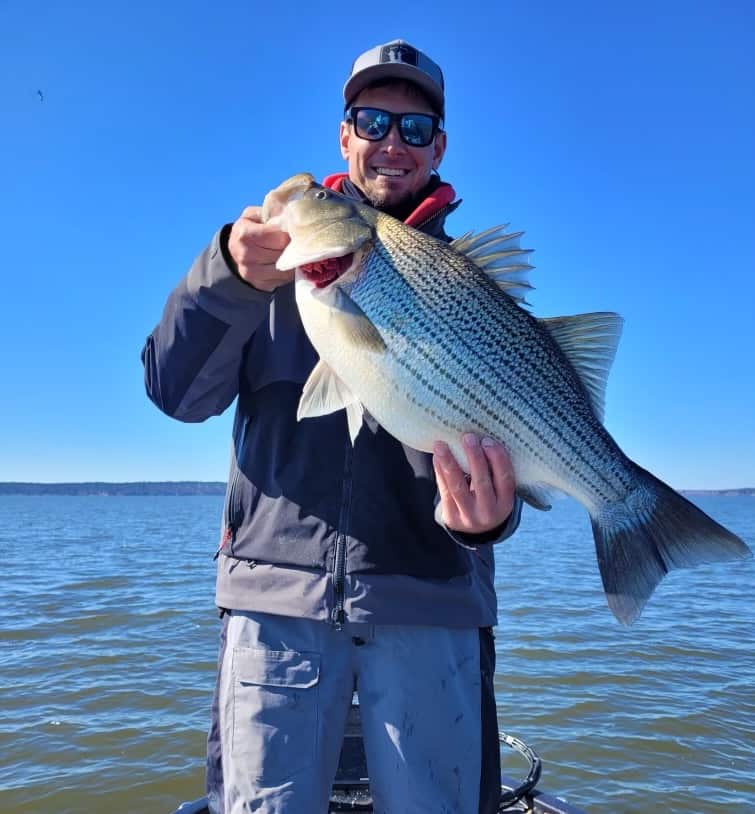
Toledo Bend Reservoir has historically offered an excellent fishery for striped bass. These anadromous fish are native to the Atlantic coast of North America and stocked in Toledo Bend for decades.
At the time of publication, stripers were last stocked in 2002.
However, we’ve just learned that there appear to be some striped bass remaining, and not just 20-year-old fish. Bent Rods Guide Service has landed more in the winter of 2022-23 than they have in many years.
For now, we’re keeping our eyes on Toledo Bend stripers. Are they making a comeback? Probably too early to tell.
However, if you’re out to catch stripers, other big Texas reservoirs like Lake Texoma likely still offer a better option. In fact, make it easy on yourself and check out our full guide to the best striped bass fishing spots in Texas.
Planning Your Trip
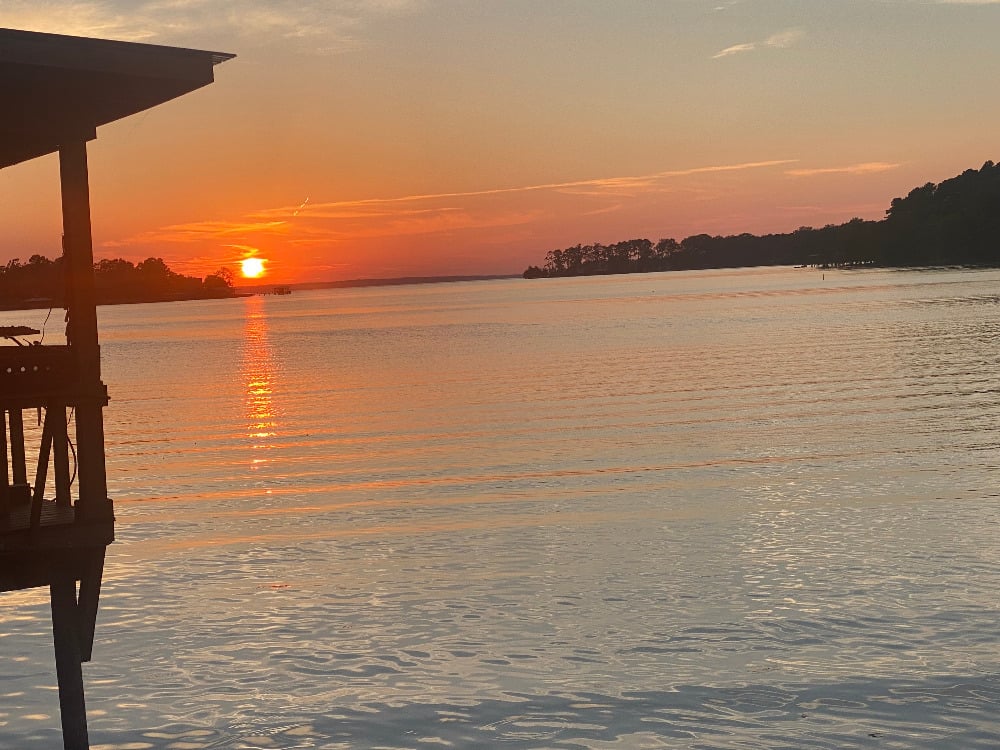
Getting to Toledo Bend
Toledo Bend Reservoir is about an hour east of Nacogdoches, Texas, and 90 minutes south of Shreveport, Louisiana.
Given the lake’s massive size and 65-mile north-to-south span, directions and distances will vary greatly depending on which part of the lake one intends to visit.
Most of the Texas side of the lake is bordered by Sabine National Forest, while the Louisiana side includes a variety of public and private lands. Texas State Highway 87 roughly parallels the lakeshore to the west, as does Louisiana State Highway 191 to the east.
There are more than 75 boat launch sites around Toledo Bend’s 1,200-mile shoreline, including state park and national forest sites, and privately owned marinas, RV parks and fish camps. We cover the most prominent public access sites below, listed from south to north for each state.
Texas Bank & Boat Access
- Sam Forse Collins Recreation Area: Located at the lowest tip of Toledo Bend Reservoir, Sam Forse Collins Recreation Area is a free public facility that offers boat ramps, ample parking, and a wheelchair-accessible fishing pier.
- Newton County Ramp: This free public boat ramp is operated by Newton County on Hickory Hill Drive overlooking Indian Creek cove.
- Willow Oak: Operated by the U.S. Forest Service as part of Sabine National Forest, Willow Oak Recreation Area includes a boat ramp and primitive campground. The day-use fee is $2 per vehicle.
- Six Mile County Ramp: Sabine County operates a free public boat ramp on Six Mile Bay, just off Texas State Highway 87. Ample parking is available for vehicles and trailers, and there is a good stretch of shoreline for bank fishing..
- Lakeview Recreation Area: The Forest Service-operated Lakeview Recreation Area offers lakeside camping on the point between Six Mile Bay and Housen Bay. Ample bank access is available, and day use is $2 per vehicle. No launch facilities are provided.
- Indian Mounds Recreation Area: A three-lane boat ramp and nearby campground are available at Indian Mounds Recreation Area, a Sabine National Forest site just south of Indian Mounds Bay.
- Carrice Creek Boat Ramp: Available to the public for a small fee, the Carrice Creek Boat Ramp is a single-lane ramp just off Texas State Highway 21 and a short distance south of the Pendleton Bridge.
- East Hamilton Ramp: The East Hamilton Ramp is a two-lane launch site with limited facilities north of Shamrock Bay. Though located within Sabine National Forest, the ramp is operated by the Sabine River Authority; a $2 launch fee is required.
- Ragtown Recreation Area: The Forest Service maintains a two-lane ramp at Ragtown Recreation Area, with a $2 per vehicle day use fee. Camping is also available, and there is modest bank fishing access. Low water may affect the usability of the ramp.
- Haley’s Ferry: Overlooking Bayou Siepe and sometimes referred to as the Bayou Siepe Boat Ramp, the Haley’s Ferry ramp is operated as a day-use facility ($2 per vehicle) by the U.S. Forest Service.
- Tenaha Creek: The one-lane Tenaha Creek boat ramp is located on its namesake creek arm, near the upper end of the lake, just off FM-139. Parking is limited, but launching is free of charge.
- Swede Johnson Recreation Area: Located at the extreme northwestern end of Toledo Bend, where it is fed by the Sabine River, Swede Johnson Recreation Area is managed by the Sabine River Authority and includes a free one-lane boat ramp with bank fishing.
Louisiana Bank & Boat Access
- South Toledo Bend State Park: As its name suggests, this is the southernmost of two state parks on the Louisiana side of the lake. South Toledo Bend State Park has boat launch facilities, a fishing pier, and a campground just above the dam.
- Pleasure Point Park: The Sabine River Authority operates Pleasure Point Park near the lower end of Toledo Bend. The 195-acre park offers camping, swimming, a fishing pier, and a two-lane boat ramp. The day use and boat launch fee is $2.
- Toledo Bend Army Recreation Park: Camping, boat launch facilities, fishing docks, fish cleaning stations and other amenities are available at Toledo Bend Army Recreation Park. The park is open only to active and retired military personnel and their families.
- Cypress Bend Park: A six-lane boat ramp and fishing pier are available at 114-acre Cypress Bend Park, a Sabine River Authority park that also offers camping and cabins. The day use and launch fee is $2.
- San Miguel Park: North of Pendleton Bridge on Bayou San Miguel, San Miguel Park is another excellent Sabine River Authority park with boat launch facilities ($2 fee) and camping.
- Clyde’s Crossing: A small tract of land at the back end of Bayou San Miguel, Clyde’s Crossing and the adjacent LA-191 bridge offer excellent bank fishing and are especially popular during the crappie spawn.
- North Toledo Bend State Park: North Toledo Bend State Park offers a fishing pier, bank access, campgrounds, and boat launch facilities at the northern mouth of Bayou San Miguel Bay.
- Hot Wells: The Sabine River Authority operates San Patricio (Hot Wells) site as a free day-use park on Bayou San Patricio. A wheelchair-accessible fishing pier is available.
- Converse Bay: The Sabine River Authority maintains free public access to Toledo Bend at a small park on Converse Bay. Bank fishing is available, and there is no charge for boat launching and tent camping.
- Oak Ridge Park: The northernmost park on the Louisiana side of Toledo Bend, Oak Ridge Park has bank fishing access, a two-lane boat ramp, ample parking and campground facilities maintained by the Sabine River Authority. Day use and launch fee is $2.
Know Before You Go
Texas and Louisiana have a reciprocal agreement that allows anglers from either state to fish any part of Toledo Bend Reservoir (by boat) using a valid fishing license from their home state.
Anyone fishing from the bank must have a license from the state they are standing on.
Certain fishing limits and seasons are different from the statewide regulations in either Texas or Louisiana, so be sure to read up on the current rules before you go.

